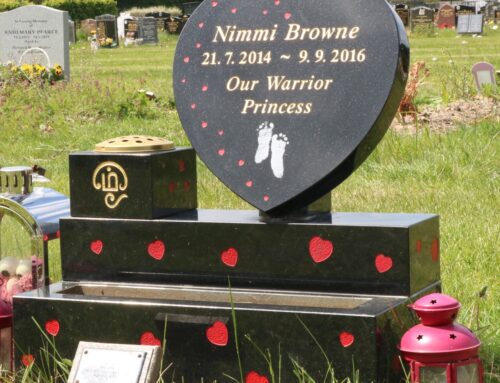Flowers have been used to convey messages and express emotions for centuries. They have a language of their own, and even in death, they continue to hold deep symbolic meaning. When we walk through cemeteries, we often notice the beautiful array of flowers adorning gravestones. Each flower has a unique significance attached to it, offering a glimpse into the life and personality of the departed. In this article, we will explore the symbolic meaning of various flowers found on gravestones, unraveling the hidden messages they convey.
Unveiling the Symbolism of Flowers
Throughout history, flowers have been used as powerful symbols in art, literature, and religious rituals. In the context of gravestones, flowers serve as a poignant reminder of the temporary nature of life and the enduring beauty of the soul. The specific flowers chosen to commemorate the departed often reflect their personality, achievements, or the emotions felt by those who mourn their loss.

Decoding the Language of Acanthus on Gravestones
Acanthus, with its deeply lobed and intricately patterned leaves, is a common motif in cemetery art. This ornate flower is often associated with everlasting love and immortality, making it a fitting symbol to honour a loved one who will never be forgotten. Its presence on gravestones offers solace and reminds us that love transcends the boundaries of life and death.
Understanding the Significance of Campanula in Memorials
Campanula, commonly known as bellflower, carries a message of gratitude and remembrance. Its delicate bell-shaped blooms symbolise gratitude for the memories shared with the departed and serve as a tribute to their enduring presence in our hearts. The presence of campanula on gravestones speaks volumes about the lasting impact the person had on those they left behind.
The Symbolic Meaning of Bluebell on Headstones
The vibrant hue of the bluebell flower has long been associated with tranquility and protection. When found on gravestones, it signifies the hope for eternal peace and serves as a protective emblem for the deceased. The fragile beauty of the bluebell reminds us of the fragility of life and the need to appreciate the moments we have in this world.
Exploring the Symbolism of Buds in Cemetery Art
Buds, as they unfurl into blossoming flowers, represent the growth and renewal of life. When depicted on gravestones, buds symbolise the spirit’s transition from the earthly realm to the ethereal plane. They remind us that even in death, there is the potential for new beginnings and the promise of a beautiful afterlife.
Daffodil Symbolism: What It Represents on Gravestones
The daffodil, with its vibrant yellow petals, represents joy and the celebration of life. Its appearance on gravestones signifies a life well-lived and encourages us to cherish the memories and experiences we create. Daffodils serve as a reminder that life, although fleeting, should be embraced with enthusiasm and optimism.
Daisy as a Symbol of Innocence and Purity in Grave Markings
The humble daisy, with its white petals and yellow centre, is a symbol of innocence and purity. When placed on gravestones, it represents the departed’s virtuous and untarnished spirit. The presence of daisies invites us to remember the goodness and purity that existed within them, leaving an indelible mark on our lives.
Dandelion: The Unexpected Symbolism on Headstones
The dandelion, often dismissed as a pesky weed, holds surprising symbolism when found on gravestones. Its delicate seeds, carried away by the wind, represent the soul’s journey beyond the earthly realm. The dandelion serves as a reminder that life is transient, and just as the wind disperses the seeds, our spirits too will move on to new adventures when our time on Earth comes to an end.
Edelweiss: A Flower of Courage and Resilience in Memorials
Edelweiss, a flower found in alpine regions, is known for its ability to endure harsh conditions. Placed on gravestones, it symbolises courage and resilience in the face of adversity. The edelweiss serves as a reminder that the departed faced life’s challenges with grace and strength, leaving an inspiring legacy for others to follow.
Evening Primrose: Unveiling Its Meaning in Cemetery Symbolism
The evening primrose, with its delicate blooms that open in the twilight hours, holds a sense of mystery in cemetery symbolism. Its appearance on gravestones signifies the transition from the earthly realm to the spiritual realm that occurs at the end of life’s journey. The evening primrose invites us to embrace the beauty of life’s final chapter and accept the eternal peace that awaits.
The Symbolic Power of Freesia on Gravestones
Freesia, with its vibrant and fragrant blossoms, symbolises friendship, trust, and innocence. When found on gravestones, it represents enduring connections and the everlasting bond between loved ones. The presence of freesia serves as a reminder of the profound impact the departed had on the lives of others and the enduring love that transcends death.
Iris Symbolism: Insights into Its Significance on Headstones
The iris, with its elegant and regal appearance, exudes wisdom and eloquence. When depicted on gravestones, the iris symbolises the departed’s profound insight and their ability to communicate their thoughts and emotions. The iris encourages us to reflect on the wisdom they imparted during their time on Earth and carry it forward in our own lives.
Lily: A Flower Rich in Symbolism on Grave Markers
The lily, with its graceful and exquisite blooms, holds rich symbolism in grave markings. It represents purity, innocence, and the restoration of the soul. When placed on gravestones, the lily signifies the departed’s liberation from worldly burdens and their transformation into a state of spiritual purity. The presence of lilies inspires us to strive for purity of heart and mind in our own lives.
Lily of the Valley: Understanding Its Symbolism in Memorials
The delicate and fragrant blooms of the lily of the valley symbolise sweetness and the return of happiness. When found on gravestones, it signifies the departed’s journey to a realm of eternal joy and serenity. The lily of the valley serves as a reminder that despite the pain of loss, there is hope for a future filled with happiness and bliss.
Lotus Flower Symbolism: Significance in Cemetery Art
The lotus flower, deeply rooted in Eastern symbolism, represents spiritual enlightenment and the triumph over adversity. When depicted on gravestones, it signifies the departed’s attainment of spiritual liberation and their transcendence from the cycles of life and death. The lotus flower invites us to reflect on our own spiritual paths and seek enlightenment in the face of life’s challenges.
Magnolia: The Symbolic Meaning on Headstones
The magnolia, with its elegant and fragrant blooms, symbolises dignity, perseverance, and nobility. When found on gravestones, it represents the departed’s strength of character and their ability to endure hardships with grace. The magnolia serves as a reminder to approach life’s trials with dignity and determination, leaving behind a legacy of resilience for future generations.
In addition to these symbolic flowers, there are countless other blooms that hold deep meaning in cemetery art. From roses representing love and passion to violets symbolising faithfulness, each flower carries its own unique message. As we wander through cemeteries, let us take a moment to appreciate the intricate language of flowers and the stories they tell. May they inspire us to reflect on our own lives, cherish our loved ones, and find solace in the beauty that surrounds us.
If you are looking to choose a Headstone, speak to our team who can offer advice and support to bear some of the burden. Contact us here – we would be happy to help.





